Before Shin Megami Tensei IV, There was Strange Journey
Why this SMT spinoff is still worth your time.
This article first appeared on USgamer, a partner publication of VG247. Some content, such as this article, has been migrated to VG247 for posterity after USgamer's closure - but it has not been edited or further vetted by the VG247 team.
The Thing was very much on my mind when I first sat down to play Shin Megami Tensei: Strange Journey back in 2010.
John Carpenter's film remains a classic of paranoid horror, fueled in large by its setting on an isolated arctic outpost. Any piece of fiction set in the North or South Pole, as Strange Journey is, can't help but evoke memories of the unbearable tension of watching Kurt Russell test each team member's blood, or that final scene amid the flaming wreckage of the research outpost as Russell and Keith David stare one another down.
I'll grant that on a superficial level, Strange Journey doesn't have much in common with The Thing. After all, SMT is about order, chaos, demons, and angels -- hardly an exemplar of the fear engendered by the Cold War that is The Thing. But what makes Strange Journey worth revisiting is the way that it still manages to evoke much the same atmosphere that made John Carpenter's horror classic so memorable. Both The Thing and Strange Journey feature isolated research teams investigating an unknown phenomenon, each knowing that the fate of the world is at stake. Both engender a degree of paranoia; anyone can be The Thing's eponymous monster, while anyone in Strange Journey can lose their mind, their free will, or both (that goes for the main character as well). And, of course, each one plays on a fear of the unknown, which is due in large part of the audience point of view being restricted to one character. Like The Thing, Strange Journey has all the makings of a very strong horror story, and it does an impressive job of following through on that potential.
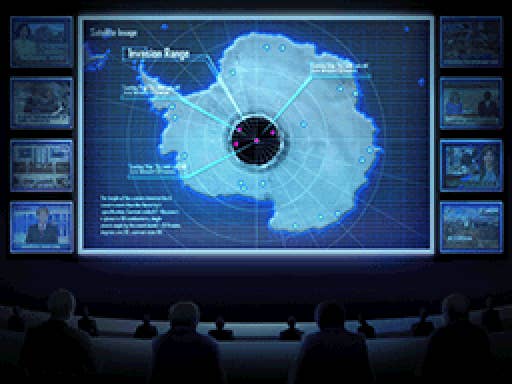
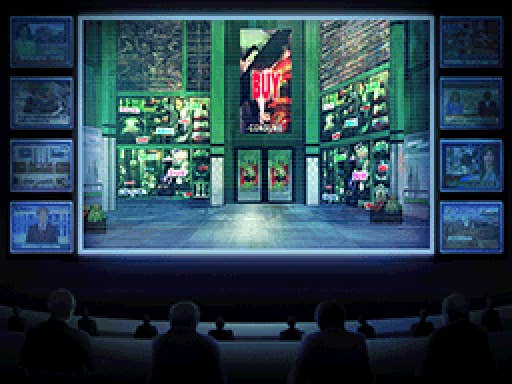
It begins with an ominous narrative about the decline of the human race in the mid-21st century. Riots, global warming, and war all threaten to overwhelm the world; and on top of everything, a bizarre black hole, a gateway to another dimension, appears in the South Pole and threatens to eventually devour the entire planet. Despite being not much more than a slideshow overview of the premise, it's effective in conveying a sense of unease that will permeate the game. In trying to figure out just what is going on with this bizarre phenomenon in the arctic, a group that appears to be the Joint Chiefs looks at camera photos of a shopping mall, a red light district, and a flaming village. Their immediate reaction: "What is this? This can't possibly be real. What is going on here?"
It's an introduction that sets the stage for exactly the sort of sci-fi story that I greatly enjoy. Strange events are afoot, no one is exactly sure of what's going on, and the audience is as much in the dark as the main characters. Thus, it's with a palpable sense of dread that a multinational crew of scientists and soldiers descends into the theatrically-named Schwarzwelt (German for "Dark World"); a feeling intensified by the fact that everything immediately goes wrong -- the transports are separated, crew members go missing, and the demons inhabiting the Schwarzwelt almost immediately converge and attack. With that, Strange Journey is able to establish a sense of mortal peril, with the only truly safe place being the main character's armored transport, the Red Sprite (though even that gets pretty dicey after a while).
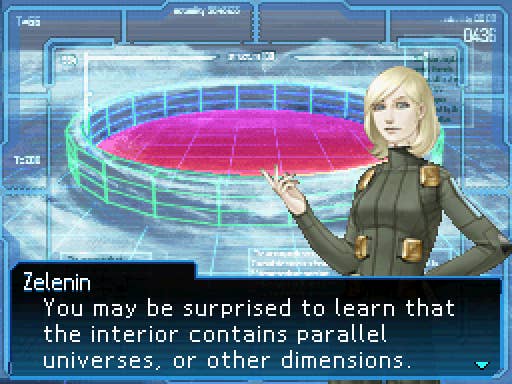
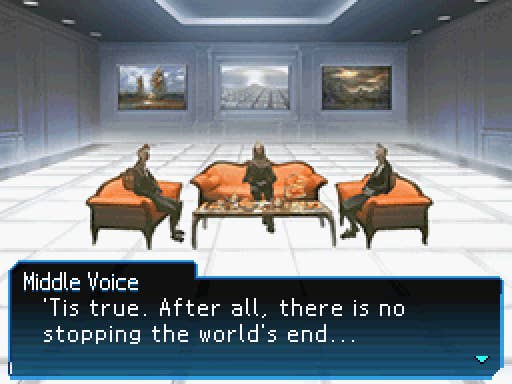
The story continues through eight sectors, not unlike Etrian Odyssey's strata, each one a riff on the different Deadly Sins ailing humanity. The most striking of these areas is Sector Carina -- a replica of a shopping mall meant to symbolize human greed. I found Carina jarring at the outset, but in a good way. It's so bright and friendly, it can't help but stand apart from Sector's A and B, which represent war and lust respectively. And yet, it's sinister as well, not the least because it's in the middle of a demonic black hole. There's also something more than a little unsettling about all those packages of meat headed... somewhere. It's familiar and yet somehow wrong, and it really shows Strange Journey at its unsettling best.
Admittedly, subtlety is not one of Strange Journey's strong points. By the time the story gets to the global warming sector, any shred of subtext has long since burned away like the flaming villages depicted in Sector Antlia. But in this instance, I'm willing to forgive Strange Journey for being a little too on the nose with its imagery, mainly because it's so successful in evoking a dark atmosphere that comes through even on the tiny Nintendo DS -- a testament to its unnerving artwork and the darkly funny way in which demons balance a sense of humor with their thirst for blood.
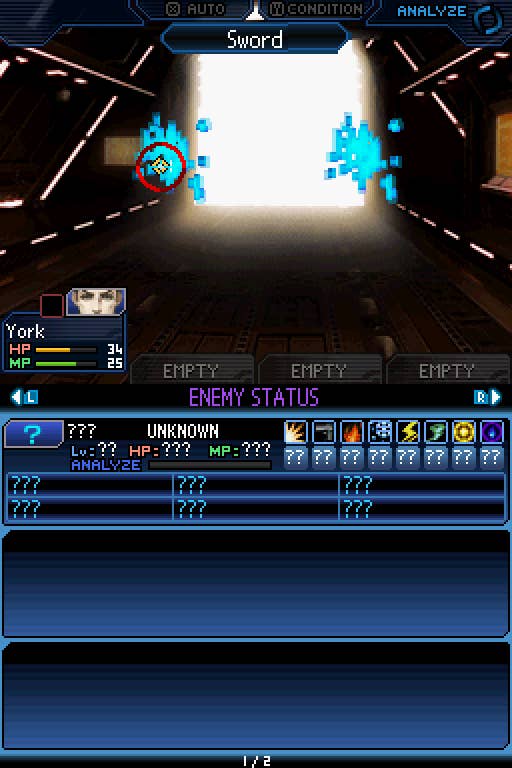
That atmosphere is ultimately what helps set it apart from more recent Shin Megami Tensei games in my mind, bringing it back to the franchise's roots, where technology plays a much more prominent role. I'll grant that Persona, Devil Survivor, and Shin Megami Tensei IV all have somewhat apocalyptic atmospheres (some more than others), but there's also a sense of mysticism in those entries that isn't quite as apparent in Strange Journey. By placing the main character in a high-tech suit and handing him a gun, Strange Journey makes the difference between humans and demons that much more acute, especially in comparison to other entries in the franchise, where Tarot cards and other magical objects are more common. Even the fact that a literal heaven and hell eventually take over doesn't disrupt Strange Journey's sensibilities too much. After all, in Event Horizon, hyperdrive is essentially used to open up the gates to hell, and the fate of one particular character in Strange Journey is reminiscent of that movie's corrupted Dr. Weir, though with more philosophy and less eye gouging.
Honestly, I just love the fact that I can compare it to classic examples of western sci-fi horror at all (okay, okay, Event Horizon is more of a cult favorite, but I digress). True, horror games aren't exactly uncommon, but it's not often that I see them employed so effectively in a turn-based RPG, not even in the long-running and very well-known Shin Megami Tensei. Most of the time, when a Japanese-developed RPG wants to delve into sci-fi, it's because they want to pay tribute to steampunk, mecha, or any number of other anime-friendly sub-genres. That's what makes the thematic similarities between Strange Journey and the likes of The Thing notable, even if it's not necessarily intentional. I guess I'm just kind of impressed that it evokes those feelings in me at all, since i'm not really used to a turn-based Japanese RPG having an atmosphere akin to, say, Dead Space.
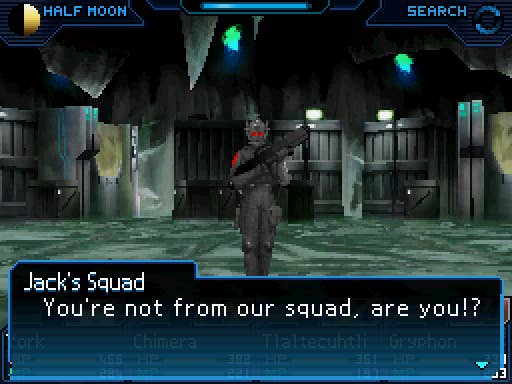

It's kind of funny, because I haven't mentioned the actual battle system much at all, but really, what else is there to say? Shin Megami Tensei's battle system hasn't changed much since the 16-bit days, and that's because its combination of demon negotiation and fusion remains really excellent. As we've seen, this battle system is flexible enough to work with a multitude of settings and genres, making it the backbone of the entire franchise. But in Strange Journey, it almost takes a backseat to the story in some ways. True, the battles are very involved, and forcing players to move toward one of three alignments to maximize the power of full-party attacks is very smart, since it ties in nicely with some of the decisions that have to be made later on. When I think of Strange Journey though, I'll always think of the Schwarzwelt first.
With that, if you haven't had an opportunity to play Strange Journey, I encourage you to do so. It's not too hard to find used on Amazon or elsewhere for a reasonable price, and it's compatible with the Nintendo 3DS. On its own, it's a really good spinoff to a classic RPG franchise, and its mechanics have much in common with the newer Shin Megami Tensei IV. But it's Strange Journey's unique atmosphere that elevates it from very good to special, and the reason that it will have a place in my 3DS for a long time to come.
[Image source: Luisfe's Let's Play series]









